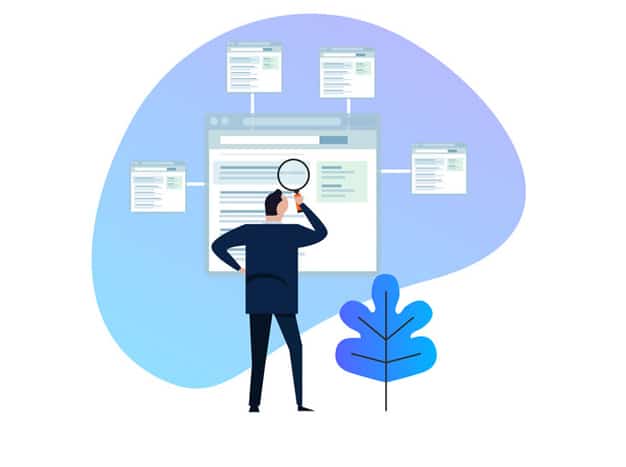![]()
A full service digital marketing agency and web design firm located in Scottsdale, Arizona.
1-877-347-3376
Email: info@spmarketingexperts.com
SP Marketing Experts
9903 E. Bell Rd., Suite #120-B Scottsdale AZ 85260
Combatting Click-Thru Rates
The internet is undoubtedly the largest and most used resource in the world. Billions of people use the internet every day to find information, shop for online products, and locate local businesses.
As you can image, search engines have a herculean task of making the internet a convenient place to find information. However, people have different ways of searching for things.
Without a brain to interpret the meaning behind trillions of query, search engines rely on artificial intelligence (AI) and machine learning to process the intent behind search queries.
That doesn’t mean that search engines do all of this work for SEOs trying to grow their online presence. If you are using keyword research to increase your online visibility, then you must first understand search intent.
Otherwise, you could be providing the wrong content to your audience and send them to another competitor. This guide will break down the complicated topic of search intent for all to understand.

What is a Click-Through Rate?
A click-through rate is a proportion of web users that click on your website or any particular page. Specifically, CTR can be measured by dividing the number of people who click on a particular link by the total number of web users.
CTR is an efficient web metric that often determines the performance and success of an online marketing campaign. If you want to truly improve your website, you can’t become overly-focused on the number of people who visit your site.
You’ll need to instead figure out the number of web users that were engaged on your site. As a result, CTR is a metric you need to monitor at least every month. If you have a low CTR, it could usually be that way for a number of reasons, which include:
- Your website is too slow.
- Your website didn’t provide valuable information.
- Your website lacked a professional design.
- Your website isn’t mobile-friendly.
These are just some reasons why people will exit your website without interacting with it. In any case, understanding the importance of CTR is important in moving forward. Here is why you should pay special attention to your CTR.
Why Does CTR Matter?
Search engine optimization (SEO) is a very extensive process. It entails taking a data-driven approach to use techniques that will impact your web ranking. One of the most effective ways of realizing if your SEO campaign is working is to check your CTR.
As it stands, your website isn’t the final point of conversion. It’s actually the first point of conversion. Once web users visit your website, they won’t become converted automatically.
This is why website views don’t carry much weight. People can view your website all day, but engaged web users are more likely to browse your site and convert. With a high CTR, your website efficiently processes new leads and turns them into loyal customers.
With a low CTR, your leaders are hitting some type of roadblock. For any of the reasons above and many more, this roadblock can become disastrous to your efforts of increasing your conversion rate.
As a result, CTR is vitally important in your SEO campaign. Knowing where you are in regards to your CTR will help you put certain steps into place to see what’s wrong with your site.
From there, you can apply repairs to your website to keep web users on your site. The most basic way of finding critical errors of your website is to perform a site audit. This comprehensive test will diagnose your website and provide you with a full report on its deficiencies.
Finally, you can move forward with fixing your website. Nonetheless, this isn’t the only step of increasing your CTR. There are trillions of websites online, and there are certainly many more that are just average.
Having an exceptional website is key, and here are some ways you can optimize your site to retain a suitable CTR.
Leverage Long-Tail Keywords
Many marketers mistakenly believe that keyword research is the end-all-be-all when it comes to SEO. You have to realize that millions of other marketers across the world use keyword research.
Unfortunately, there are a lot of businesses that target the same popular keywords. This creates a disproportionate amount of competition for keywords a lot of people are using. That presents marketers with a conundrum. How can they rank for popular keywords when they are being targeted by all of their competitors?
The answer is simple. You should use more long-tail keywords. Long-tail keywords are longer than traditional keywords. An example of a long-tail keyword is “best personal injury lawyer in Los Angeles.”
Fortunately, there are countless variations of long-tail keywords. There are enough long-tail keywords for everyone, which makes it more essential to target them to reach a broader audience.
You can’t put all of your eggs in one basket. Instead, put all of your efforts on not just popular keywords, but a wide variety of long-tail keywords to ensure that your website appears for an abundance of different search queries.

Understand Search Intent
Earlier in the series, search intent was thoroughly discussed. Now, it makes sense why. If your website isn’t receiving meaningful traffic, then it probably means that you aren’t giving your users what they want or need.
Furthermore, this can only happen if you misinterpret the true meaning behind your list of keywords. Let’s use the previous keyword, “best personal injury lawyer in Los Angeles.” as an example.
What do you think web users are looking for when they type this keyword in a search bar? Here are two plausible answers.
- They want to find some of the top attorneys in their area.
- They want more information on how to find a quality attorney.
So, which one is the right answer? You’ll never know unless you simply type in the keyword and see what are the highest-ranking results. If a majority of the results contain Google Maps listings and landings pages of popular attorneys, the first answer is correct.

However, if a majority of the results contain informational articles and tips on selecting a suitable attorney, then the second one suffices. Many marketers blindly perform keyword research and implement their selected keywords on their website without understanding its intent.
Doing so will not put you in the position of knowing what your audience wants. As such, you’ll be wasting your time creating a landing page or article that your audience didn’t ask for.
Write Effective Metadata
Metadata is information that exists below a search result. This includes the title tag and meta description. The title tags are the blue links on search engine result pages (SERPs) that helps you see the topics of the pages you’re about to click on.
A meta description is a summary of what a web page is about. If you’ve ever used the internet, you’ve likely used metadata to choose an article to read or find a local business. Consumers do the same, so you should ensure that your metadata is perfectly constructed.
For web pages, make sure that your title tag contains a focus keyword and a succinct description of what your business is about. The meta description should summarize the page and include a brief call-to-action (CTA).
For blogs, you should craft an enticing title tag to get users to click. In the meta description, you can summarize the post and include a focus keyword. You are free to insert a focus keyword in the title tag if it’s appropriate.

Receive a Featured Snippet
If you type in a question into Google’s search bar, you’ll likely see the answer at the top of the SERP in the form of a paragraph, list, or table. This is called a featured snippet. Google does this to present the most valuable information at the forefront of their SERPs.
As you can imagine, having a place at the top of Google’s SERPs can lead to an abundance of qualified leads. It’s actually simple to receive a featured snippet. First, you must identify snippet opportunities.
If you scroll down far enough, you should see questions “people also ask”. By including a FAQ section on your website that contains the answers to these questions, you can naturally acquire rich snippets for your website.
You can also do the same by writing how-to articles on your site. If your article is high-quality and correctly optimized, Google will feature it. Remember that rich snippets are the pinnacle of quality information.
Google only puts the best data in these slots. Therefore, make sure your content is exceptional to give yourself the best chance of ranking even above the first search result and increasing your CTR.

Always Perform Tests
In regards to your metadata, you should always conduct A/B experiments to see which variations work best for your website. Over time, you will develop a strategy that delivers traffic to your site.
Testing can take several months before you see tangible results. Nonetheless, it’s highly necessary to test your campaign to see what works and what doesn’t.
Conclusion
The CTR of your website is the greatest indicator of its performance. By following this guide, you can allow an abundance of meaningful web traffic to enter your website. As the final part of this series, the next post will discuss backlink strategies you can employ to further boost your web ranking.

Next in Series: Backlink Backlink Backlink
Reviews
I use SP Marketing for a number of things but I have to mention how useful it’s been having them help with Google Pay per click management. This company is fantastic at what they do. They are on top of everything and they are always so professional. I really don’t know what I would do without them. If you need any kind of digital marketing help this is the first place I would recommend. They put a lot of emphasis on customer care and they have really helped my business grow.
We hired SP Marketing to run online and social media ads for our company. I wasn’t really sure what to expect but decided it was worth a shot. The uptick in sales has been wonderful. These guys really know what they’re doing and their ads have brought us so many new customers. I’m so thankful. I highly recommend them.
I just love SP Marketing Experts. I needed some major help with link and citation building and these guys were able to handle everything for me. Their services have been so useful. I can't remember the last time I worked with a company that had such great customer service. If you're looking for any kind of digital marketing help for your company this is the first and only company I would recommend.
SP Marketing helped us completely redo our website. The old one was such a mess and we needed so much help. The end result was modern, easy to read, and very user friendly. I couldn’t be happier with their services. They did such a great job for us. I would 100% recommend them to anyone who has a business and needs website or marketing help. They do a fantastic job. They really delivered for us.
In order to stay competitive as a business you have to be regularly posting on social media. However, I own a small business and managing my own social media while I’m trying to run a company isn’t really productive. Thankfully, I found SP Marketing. They have been great. They do all of our social posts for us so that I don’t have to worry about it. It’s really helped the business grow. They are very professional and very easy to work with. I don’t know what I did without them.
I use SP Marketing for a number of things but I have to mention how useful it’s been having them help with Google Pay per click management. This company is fantastic at what they do. They are on top of everything and they are always so professional. I really don’t know what I would do without them. If you need any kind of digital marketing help this is the first place I would recommend. They put a lot of emphasis on customer care and they have really helped my business grow.
We hired SP Marketing to run online and social media ads for our company. I wasn’t really sure what to expect but decided it was worth a shot. The uptick in sales has been wonderful. These guys really know what they’re doing and their ads have brought us so many new customers. I’m so thankful. I highly recommend them.
I just love SP Marketing Experts. I needed some major help with link and citation building and these guys were able to handle everything for me. Their services have been so useful. I can't remember the last time I worked with a company that had such great customer service. If you're looking for any kind of digital marketing help for your company this is the first and only company I would recommend.
SP Marketing helped us completely redo our website. The old one was such a mess and we needed so much help. The end result was modern, easy to read, and very user friendly. I couldn’t be happier with their services. They did such a great job for us. I would 100% recommend them to anyone who has a business and needs website or marketing help. They do a fantastic job. They really delivered for us.
In order to stay competitive as a business you have to be regularly posting on social media. However, I own a small business and managing my own social media while I’m trying to run a company isn’t really productive. Thankfully, I found SP Marketing. They have been great. They do all of our social posts for us so that I don’t have to worry about it. It’s really helped the business grow. They are very professional and very easy to work with. I don’t know what I did without them.
I use SP Marketing for a number of things but I have to mention how useful it’s been having them help with Google Pay per click management. This company is fantastic at what they do. They are on top of everything and they are always so professional. I really don’t know what I would do without them. If you need any kind of digital marketing help this is the first place I would recommend. They put a lot of emphasis on customer care and they have really helped my business grow.
We hired SP Marketing to run online and social media ads for our company. I wasn’t really sure what to expect but decided it was worth a shot. The uptick in sales has been wonderful. These guys really know what they’re doing and their ads have brought us so many new customers. I’m so thankful. I highly recommend them.
I just love SP Marketing Experts. I needed some major help with link and citation building and these guys were able to handle everything for me. Their services have been so useful. I can't remember the last time I worked with a company that had such great customer service. If you're looking for any kind of digital marketing help for your company this is the first and only company I would recommend.
SP Marketing helped us completely redo our website. The old one was such a mess and we needed so much help. The end result was modern, easy to read, and very user friendly. I couldn’t be happier with their services. They did such a great job for us. I would 100% recommend them to anyone who has a business and needs website or marketing help. They do a fantastic job. They really delivered for us.
In order to stay competitive as a business you have to be regularly posting on social media. However, I own a small business and managing my own social media while I’m trying to run a company isn’t really productive. Thankfully, I found SP Marketing. They have been great. They do all of our social posts for us so that I don’t have to worry about it. It’s really helped the business grow. They are very professional and very easy to work with. I don’t know what I did without them.
I use SP Marketing for a number of things but I have to mention how useful it’s been having them help with Google Pay per click management. This company is fantastic at what they do. They are on top of everything and they are always so professional. I really don’t know what I would do without them. If you need any kind of digital marketing help this is the first place I would recommend. They put a lot of emphasis on customer care and they have really helped my business grow.
We hired SP Marketing to run online and social media ads for our company. I wasn’t really sure what to expect but decided it was worth a shot. The uptick in sales has been wonderful. These guys really know what they’re doing and their ads have brought us so many new customers. I’m so thankful. I highly recommend them.
I just love SP Marketing Experts. I needed some major help with link and citation building and these guys were able to handle everything for me. Their services have been so useful. I can't remember the last time I worked with a company that had such great customer service. If you're looking for any kind of digital marketing help for your company this is the first and only company I would recommend.
SP Marketing helped us completely redo our website. The old one was such a mess and we needed so much help. The end result was modern, easy to read, and very user friendly. I couldn’t be happier with their services. They did such a great job for us. I would 100% recommend them to anyone who has a business and needs website or marketing help. They do a fantastic job. They really delivered for us.
In order to stay competitive as a business you have to be regularly posting on social media. However, I own a small business and managing my own social media while I’m trying to run a company isn’t really productive. Thankfully, I found SP Marketing. They have been great. They do all of our social posts for us so that I don’t have to worry about it. It’s really helped the business grow. They are very professional and very easy to work with. I don’t know what I did without them.
Statistical Performance Marketing
Statistical Performance Marketing is a full service digital marketing agency and web design firm located in Scottsdale, Arizona.
1-877-347-3376
Statistical Performance Marketing
www.spmarketingexperts.com
9903 E. Bell Rd., Suite #120-B
Scottsdale
AZ
85260
Statistical Performance Marketing is a digital marketing agency and web design firm specializing in a variety of online marketing channels. Since our founding in 1999, it has been our goal to help all businesses run more efficiently and effectively online with outreach and remarketing campaigns. Combined, our team of designers, developers, and marketing experts have over 40 years of experience and an ever-growing drive for success.
© 2023 Statistical Performance Marketing | All rights reserved




